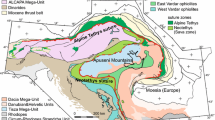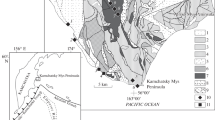Abstract
The paper presents the results from a study of original and published data on the chemical composition and age of mantle peridotites from Sakhalin Island ophiolites. The material and genetic proximity of peridotites from the Berezovsky and Shelting plutons, on the one hand, and mélange zone serpentinites, on the other, have been established. In composition and Fe2O3 and MgO variations, Sakhalin peridotites differ radically from those of the Northeast Asia ophiolite complexes (Krasnogorsky Massif, Karaginsky Island Massif, etc.), which are fragments of Pacific Plate mantle. Conversely, Sakhalin peridotites have a subcontinental genesis and are compositionally close to xenoliths of lherzolites from Hankai Microcontinent mantle (southern Sikhote-Alin). The rythmics of alternation in compression and expansion at the margin of the Asian continent in the last 180 million years, caused by cyclical changes in the Pacific spreading rate, have been considered. According to data obtained by U-Pb dating of zircons, the formation of the Berezovsky Massif took place 169–154 Ma ago during Jurassic expansion of the continental margin. Matching age and composition data demonstrate that the Sakhalin ophiolites formed within the marginal sea basin during riftinduced destruction of the periphery of the Hankai Craton. The assumed tectonic setting was close to that reconstructed for the Jurassic Josephine ophiolites of the California margin of the North American continent. The continental genesis of the studied ophiolites agrees with the age and tectonic mode of ophiolite formation for Sakhalin Island.
Similar content being viewed by others
References
V. F. Belyi and V. V. Anikin, Geological Structure and Ophiolites of Elistratov Peninsula: Monograph (Northeastern Comprehensive Scientific Research Inst., Magadan, 1985), Part 1.
A. F. Bekhtol’d and D. F. Semenov, “New data on the composition and structure of the Shel’tingskii gabbroperidotite pluton (Sakhalin Island) (Sakhalin Island),” Dokl. Akad. Nauk SSSR 243, 445–448 (1978).
A. F. Bekhtol’d and D. F. Semenov, “Metabasites and hyperbasites of the Susunaiskii Ridge (Sakhalin Island),” Tikhookean. Geol., No. 1, 121–126 (1990).
V. V. Velinskii, Alpinotypic Hyperbasites of Ocean-Continent Transition Zones (Nauka, Novosibirsk, 1979) [in Russian].
G. P. Vergunov, “New data on ultrabasic rocks of Sakhalin and the Kuril Islands,” Dokl. Akad. Nauk SSSR 158, 629–637 (1964).
S. V. Vysotskii, G. I. Govorov, I. V. Kemkin, and V. I. Sapin, “Boninite-ophiolite association of Eastern Sakhalin: geology and petrogenesis,” Tikhookean. Geol. 17 (6), 3–15 (1998).
Geodynamics, Magmatism, and Metallogeny of Eastern Russia, Ed. by A. I. Khanchuk (Dal’nauka, Vladivostok, 2006), Book 1.
Geochemistry of Deep Volcanic Rocks and Xenoliths (Nauka, Moscow, 1980) [in Russian].
E. D. Golubeva, Candidate’s Dissertation in Geology-Mineralogy (Vladivostok, 1975).
State Geological Map of Russian Federation, Scale 1: 200000, Sakhalin Series, Sheet M-54-XXIV (Pervomaisk), Explanatory Note (All-Russian Scientific Research Geological Inst., St. Petersburg, 2009) [in Russian].
V. M. Grannik, “Petrogeochemical characteristics of magmatic rocks of the East Sakhalin Late Mesozoic island arc system,” Tikhookean. Geol. No. 6, 67–86 (1991).
A. E. Zharov, “Accretionary tectonics and geodynamics of southern Sakhalin,” Geotectonics 38, 277–293 (2004).
I. V. Kemkin, “Structure of terranes in a Jurassic accretionary prism in the Sikhote-Alin-Amur area: implications for the Jurassic geodynamic history of the Asian eastern margin,” Russ. Geol. Geophys. 49, 759–770 (2008).
D. V. Kovalenko, Paleomagnetism of Geological Complexes of Kamchatka and South Koryakia. Tectonic and Geophysical Interpretation (Nauchnyi Mir, Moscow, 2003) [in Russian].
M. V. Kononov, Tectonics of Northwestern Plates of Pacific Ocean (Nauka, Moscow, 1989) [in Russian].
F. P. Lesnov, M. P. Gora, V. A. Bobrov, et al., “Distribution of rare-earth elements and genesis of the Berezovskii mafic-ultramafic massif (Sakhalin Island),” Tikhookean. Geol. 17 (4), 42–58 (1998).
F. P. Lesnov and A. A. Stepashko, “New data on the chemical composition of the rocks of the mafic-ultramafite massifs of the East Sakhalin ophiolite association,” Proceedings of Conference “Metallogeny of Ancient and Modern Oceans” (Miass, 2010), pp. 234–239.
F. P. Lesnov, V. G. Gal’versen, V. G. Tsimbalist, and A. T. Titov, “First data on the U–Pb isotopic dating and original platinum content of the Berezovskii polygenic mafic-ultramafic massif (Sakhalin Island),” Dokl. Earth Sci. 433, 1104–1107 (2010).
F. P. Lesnov, Petrology of Polygenic Mafic-Ultramafic Massifs of East Sakhalin Ophiolite Association (GEO, Novosibirsk, 2015) [in Russian].
Explanatory Note to Tectonic Map of the Sea of Okhotsk Region, Ed. by N. A. Bogdanov and V. E. Khain (Institute of the Lithosphere of Marginal and Inland Seas, Russian Academy of Sciences, Moscow, 2000) [in Russian].
A. A. Peive, “The structure and structural position of ophiolites of Koryak Ridge,” Tr. Geol. Inst., Akad. Nauk SSSR, No. 393, (1984).
G. V. Pinus, V. V. Velinskii, F. P. Lesnov, et al., Alpinotype Hyperbasites of the Anadyr-Koryak Folded System (Nauka, Novosibirsk, 1973) [in Russian].
Yu. N. Raznitsin, “The ophiolite allochthons and adjacent deep-sea depressions in the Western Pacific,” Tr. Geol. Inst., Ross. Akad. Nauk 371, (1982).
D. P. Savel’ev, “Stages of tectonic evolution of ophiolite complexes in the zone of the Kamchatka-Aleutian junction,” Proceedings of the Conference in Memoriam of L.M. Parfenov “Tectonics and Metallogeny of the Northern Circum-Pacific and East Asia” (Institute of Tectonics and Geophysics, Far Eastern Branch, Russian Academy of Sciences, Khabarovsk, 2007), pp. 302–303.
V. V. Slodkevich, “Shel’tingskii peridotite-pyroxenitenorite layered pluton of Eastern Sakhalin,” Dokl. Akad. Nauk SSSR 222, 946–949 (1975).
V. V. Slodkevich and F. P. Lesnov, “Geology and petrology of Berezovskii mafic-ultramafic pluton (Sakhalin Island),” in The Data on Genetic and Experimental Mineralogy (Nauka, Novosibirsk, 1976), Vol. 10, pp. 53–63.
A.A. Stepashko, The Chemical Structure of the Ultrabasic Mantle (Dal’nauka, Vladivostok, 1998) [in Russian].
A. A. Stepashko, “Origin of West Pacific seamounts and features of the cretaceous dynamics of the Pacific plate,” Oceanology (Engl. Transl.) 46, 411–417 (2006).
A. A. Stepashko, “The cretaceous dynamics of the pacific plate and stages of magmatic activity in Northeastern Asia,” Geotectonics 40, 225–235 (2006).
A. A. Stepashko, “Spreading cycles in the Pacific Ocean,” Oceanology (Engl. Transl.) 48, 401–408 (2008).
A. I. Khanchuk, I. V. Panchenko, and I. V. Kemkin, Preprint No. 224, DVO AN SSSR (Far Eastern Branch, Academy of Sciences of Soviet Union, Vladivostok, 1988).
A. I. Khanchuk and I. V. Kemkin, “Geodynamic evolution of the Sea of Japan region in Mesozoic,” Vestn. Dal’nevost. Otd., Ross. Akad. Nauk, No. 6, 94–108 (2003).
A. D. Chekhov, Tectonic Evolution of Northeastern Asia: Marine Marginal Model (Nauchnyi Mir, Moscow, 2000) [in Russian].
M. N. Shapiro, A. V. Solov’ev, and J. K. Hourigan, “Lateral structural variability in zone of eocene islandarc-continent collision, Kamchatka,” Geotectonics 42, 469–487 (2008).
S. A. Shcheka, Basite-Hyperbasite Intrusions and Inclusions in the Volcanic Rocks of the Far East (Nauka, Moscow, 1983) [in Russian].
K. Aoki, S. Maruyama, Y. Isozaki, et al., “Recognition of the Shimanto HP metamorphic belt within the traditional Sanbagawa HP metamorphic belt: New perspectives of the Cretaceous-Palaeogene tectonics in Japan,” J. Asian Earth Sci. 42, 355–369 (2011).
F. Deschamps, M. Godard, S. Guillot, and K. Hattori, “Geochemistry of subduction zone serpentinites: a review,” Lithos 178, 96–127 (2013).
Y. Dilek and A. Polat, “Suprasubduction zone ophiolites and Archean tectonics,” Geology 36 (5), 431–432 (2008).
D. C. Engebretson, A. Cox, and R. G. Gordon, “Relative motions between oceanic plates in the Pacific basin,” J. Geophys. Res. 89 (12), 10291–10310 (1984).
O. F. Gaul, W. L. Griffin, S. Y. O’Reilly, and N. J. Pearson, “Mapping olivine composition in the lithospheric mantle,” Earth Planet. Sci. Lett. 182 (3–4), 223–235 (2000).
W. L. Griffin, B. J. Doyle, C. G. Ryan, et al., “Layered mantle lithosphere in the Lac de Gras area, Slave craton: composition, structure and origin,” J. Petrol. 40, 705–727 (1999).
W. L. Griffin, S. Y. O’Reilly, J. C. Afonso, and G. C. Begg, “The composition and evolution of lithospheric mantle: a re-evaluation and its tectonic implications,” J. Petrol. 50 (7), 1185–1204 (2009).
G. D. Harper, J. B. Saleeby, and M. Heizler, “Formation and emplacement of Josephine ophiolite and the Nevada orogeny in the Klamath mountains, California–Oregon: U/Pb zircon and 40Ar/39Ar geochronology,” J. Geophys. Res.: Solid Earth 99 (3), 4293–4321 (1994).
G. D. Harper, “Tectonic implications of boninite, arc tholeiite, and MORB magma types in the Josephine ophiolite, California–Oregon,” Geol. Soc. Spec. Publ. (London) 218, 207–230 (2003). doi 10.1144/GSLSP.2003.210.01.12
C. Herzberg, “Geodynamic information in peridotite petrology,” J. Petrol. 45 (12), 2507–2530 (2004).
A. Ishiwatari, S. D. Sokolov, and S. V. Vysotskiy, “Petrological diversity and origin of ophiolites in Japan and Far East Russia with emphasis on depleted harzburgite,” in Ophiolites in Earth History, Geol. Soc. Spec. Publ. (London) no. 218 (Geological Society, London, 2003), pp. 597–617.
T. Itaya, T. Tsujimori, and J. G. Liou, “Evolution of the Sanbagawa and Shimanto high-pressure belts in SW Japan: insights from K–Ar (Ar–Ar) geochronology,” J. Asian Earth Sci. 42, 1075–1090 (2011).
G. Kimura, V. S. Rodzdestvenskiy, K. Okumura, et al., “Mode of mixture of oceanic fragments and terrigenous trench fill in an accretionary complex: example from southern Sakhalin,” Tectonophysics 202 (2–4), 361–374 (1992).
G. Manatschal and O. Muntener, “A type sequence across an ancient magma-poor ocean-continent transition: the example of the western Alpine Tethys ophiolites,” Tectonophysics 473, 4–19 (2009).
W. F. McDonough and S. S. Sun, “The composition of the Earth,” Chem. Geol. 120, 223–253 (1995).
Q.-R. Meng, “What drove late Mesozoic extension of the northern China–Mongolia tract?,” Tectonophysics 369, 155–174 (2003).
M. M. Miller and J. B. Saleeby, “U–Pb geochronology of detrital zircon from Upper Jurassic synorogenic turbidites, Galice Formation, and related rocks, western Klamath Mountains: correlation and Klamath Mountains provenance,” J. Geophys. Res.: Solid Earth 100 (9), 18045–18058 (1995).
E.-R. Neumann and N. S. C. Simon, “Ultra-refractory mantle xenoliths from ocean islands: How do they compare to peridotites retrieved from oceanic sub-arc mantle?,” Lithos 107, 1–16 (2009).
Y. Niu, “Bulk-rock major and trace element composition of abyssal peridotites: implications for mantle melting, melt extraction and post-melting processes beneath mid-ocean ridges,” J. Petrol. 45 (12), 2423–2458 (2004).
S. Y. O’Reilly and W. L. Griffin, “Imagine global chemical and thermal heterogeneity in the subcontinental lithospheric mantle with garnets and xenoliths: geophysical implications,” Tectonophysics 416, 289–309 (2006).
Ophiolites and Oceanic Crust: New Insights from Field Studies and the Ocean Drilling Program, Ed. by Y. Dilek, (Geological Society of America, Boulder, 2000), Vol. 349.
Ophiolites in Earth History, Ed. by Y. Dilek and P. T. Robinson (Geological Society of London, London, 2003), Vol. 218.
Y.-I. Otofuji, “Large tectonic movement of the Japan Arc in Late Cenozoic times inferred from paleomagnetism: review and synthesis,” Island Arc 5 (3), 229–249 (1996).
D. G. Pearson and N. Witting, “Formation of Archaeon continental lithosphere and its diamonds: the root of the problem,” J. Geol. Soc. 165, 895–914 (2008).
P. Peltonen and G. Brugmann, “Origin of layered continental mantle (Karelian craton, Finland): geochemical and Re–Os isotope constraints,” Lithos 89, 405–423 (2006).
J. Ren, K. Tamaki, S. Li, and J. Zhang, “Late Mesozoic and Cenozoic rifting and its dynamic setting in Eastern China and adjacent areas,” Tectonophysics 344, 175–205 (2002).
D. B. Snyder, “Lithospheric growth at margins of cratons,” Tectonophysics 355, 7–22 (2002).
S. D. Sokolov, M. V. Luchitskaya, S. A. Silantyev, et al., “Ophiolites in accretionary complexes along the Early Cretaceous margin of NE Asia: age, composition and geodynamic diversity,” in Ophiolites in Earth History, Ed. by Y. Dilek and P. T. Robinson (Geological Society of London, London, 2003), Vol. 218, pp. 619–664.
A. A. Stepashko, “Cretaceous seamounts: record of the extension history of the Pacific plate,” in New Oceanography Research Developments: Marine Chemistry, Ocean Floor Analyses and Marine Phytoplankton, Ed. by L. Mortorino and P. K. Hauppauge (Nova Science, New York, 2010), pp. 249–267.
M. Ulrich, C. Picard, S. Guillot, et al., “Multiple melting stages and refertilization as indicators for ridge to subduction formation: the New Caledonia ophiolite,” Lithos 115, 223–236 (2010).
H. Yuan and B. Romanowicz, “Lithospheric layering in the North American craton,” Nature 466, 1063–1068 (2010).
Author information
Authors and Affiliations
Corresponding author
Additional information
Original Russian Text © A.A. Stepashko, F.P. Lesnov, 2018, published in Okeanologiya, 2018, Vol. 58, No. 3, pp. 488–500.
Rights and permissions
About this article
Cite this article
Stepashko, A.A., Lesnov, F.P. Oceanic and Continental Mantle Fragments in Ophiolites of the Northwestern Pacific Margins: Composition, Age, and Genesis of Sakhalin Peridotites. Oceanology 58, 459–469 (2018). https://doi.org/10.1134/S0001437018030189
Received:
Accepted:
Published:
Issue Date:
DOI: https://doi.org/10.1134/S0001437018030189




